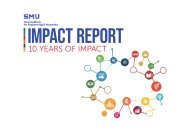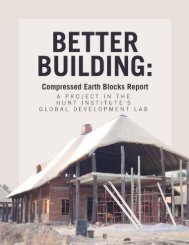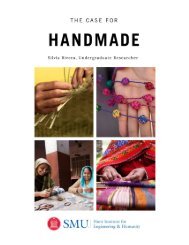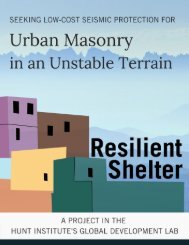Assessment of Rwanda Refugee Camps in the Context of the Villagization Process
Undergraduate researcher for the Hunt Institute for Engineering and Humanity and Engaged Learning Fellow Sienna Dugan, researched secondary sources and primary research through site visits, participatory observation, and interviews with key informants to compile this report which is structured like a case study with additional literature review. All photography is original to the student from her in-field research.
Undergraduate researcher for the Hunt Institute for Engineering and Humanity and Engaged Learning Fellow Sienna Dugan, researched secondary sources and primary research through site visits, participatory observation, and interviews with key informants to compile this report which is structured like a case study with additional literature review. All photography is original to the student from her in-field research.
You also want an ePaper? Increase the reach of your titles
YUMPU automatically turns print PDFs into web optimized ePapers that Google loves.
Executive Summary
The world is currently experiencing the highest rate of displaced people, 149,602 of whom
are seeking shelter in refugee camps in Rwanda. The United Nations High Commissioner for
Refugees (UNHCR) assumes the majority of responsibility for these people offering protection
and ensuring adequate standards of living. Established in 1850, UNHCR has since worked to
codify international refugee law rooted in Article 14 of the Universal Declaration of Human
Rights. Although various documents such as the UNHCR Handbook for Emergencies and the
Sphere Project Humanitarian Charter outline minimum standards for maintaining refugee camps,
new issues continue to arise from prolonged displacement.
Continuously in search of sustainable solutions for refugees and refugee camps, UNHCR
Rwanda has recently adopted the Comprehensive Refugee Response Framework (CRRF) which
aims to ease pressures on host countries; enhance refugee self-reliance; expand access to thirdcountry
solutions; and support conditions in countries of origin for return in safety and dignity.
With aims to have all refugees, including potential new influxes, living safe, dignified, and
productive lives outside of camps, supported by governmental services and programs by 2030,
processes to transform Mahama Camp into a self-sustaining village have begun to be explored.
The methodology used for this report is primarily the case study approach and additionally
a literature review. Further data was collected from cite visits, participatory observation, and
interviews with key informants. The objectives are to assess the current condition of refugee
camps in Rwanda providing a by sector analysis of needs focusing on Mahama Camp, identify
how UNHCR Rwanda is using CRRF to respond to the protracted and growing refugee situation
3














